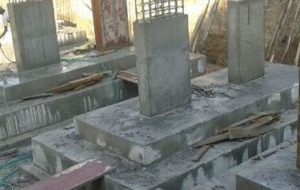Spread Footing | Equation, 4 Types & Benefits of Spread Footing
The spread footing is used to support the column and walls and also transmit and distribute the load coming on the structure to the soil below it.
With loads applied in the upward direction, this footing behaves like an inverted cantilever, and this type of footing is quite rigid element & they are orthogonal in case of symmetric footing.
This type of footing is a circular, square, or rectangular slab of uniform thickness and to spread the load over a large area sometimes it is stepped or haunched.

A spread footing base is wider than a typical load-bearing wall foundation and spreads the weight from the building structure above more area and provides recommended stability.
Where the bearing soil layer is within 10 feet from the ground surface, this type of footing is used for individual columns, walls, and bridge piers.
If there is any possibility of a ground flow of water above bearing layer of soil which may result in scour or liquefaction, these should not be used on such soils.
The Formula for Determining Area of Spread Footing:
Using the following formula, the base area of the spread footing is calculated;

Where,
The total load coming on the spread footing is Qt &
q is the base area of spread footing.
Types of Spread Footing:
There are four types of this footing as given below;
- Isolated Spread Footing
- Combined Footing
- Strip Footing
- Mat Foundation
Isolated Spread Footing:
It is a type of shallow foundation typically used for shallow establishments to convey and spread concentrated burdens by pillars or columns and used for ordinary buildings.
Directly at the base of the segment isolated footing comprises a foundation and transfers the loads from the column to the soil and it might be rectangular, roundabout, or square.

By dividing the total load at the column base by the allowable bearing capacity of the soil the size of the footing can be roughly calculated.
Combined Footing:
A combined footing is required when two columns are close to each other and their individual footings overlap and this footing supports two columns and it may be trapezoidal or rectangular.

Strip Footing:
Strip footings are used to distribute loads of structural or non- structural load-bearing walls to the ground.
Strip footing distributes loads in such a way that the load-bearing limit of the soil is not outperformed and the width of the wall foundation is usually 2 to 3 times greater than the width of the wall.

Strip footings are economical when the small magnitude loads to be transmitted or when it is placed on dense gravel and sand.
Mat Foundation:
A mat foundation supports several columns and walls under the entire structure and is a large slab. A single footing for all columns is provided if several columns overlap each other and are called mat footing.

To reduce the differential settlements on non-homogeneous soils mat foundations are used.
Benefits of Spread Footing:
For providing the spread footing as a foundation in the building, there are the following advantages such as;
- For providing greater stability, the spread footing transmits and distributes the load from the structure over the larger area of soil beneath it.
- As compared to other types of footing, spread footing has very little risk of failure.
- By controlling the damage in the structures, this type of footing increases the life of the buildings.
- These footings are used to provide support to the structure continuously.
- These footings are easy to provide in the building structures.
- As compared to load-bearing foundation a spread footing foundation has a wider bottom portion and for greater stability over a large area, the wider bottom spreads the weight of the structure.
- These footings are constructed with concrete and reinforced with steel to add additional support.
- In residential construction, these footings are commonly used.
